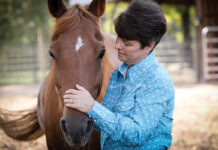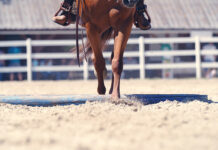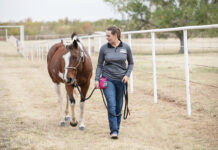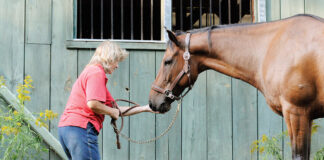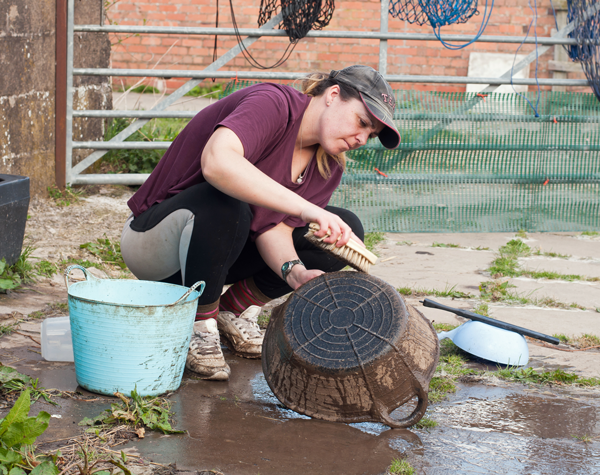
One stable chore that should be done regularly is cleaning and disinfecting the containers from which a horse eats and drinks. Completing this task so your horse has clean feed equipment is more than a quick rinse under the water hydrant; it involves several critical steps and an understanding of what products to use for each step.
“As feed is added to hay nets, new potential contamination is added,” continues Norman. “Rinsing hay nets between hay additions can help, especially if disease has been on the farm previously. Another common example of a biosecurity hazard is the end of the hose going from bucket to bucket of water—it can spread Streptococcus bacteria that cause strangles.”
Why Clean Horse Feed Equipment?
There are many reasons for taking the time to clean buckets, feed tubs, water tanks, hay nets, feed scoops and feed storage bins, etc. These include:
◆ Improved general horse health: Clean food and water containers promote healthy respiratory and digestive systems.
◆ Preventing the spread of diseases: Many diseases can spread through saliva, mucous from coughing and sneezing, nasal discharge, and drainage from abscesses. These bodily fluids can all rapidly spread diseases, such as strangles, equine influenza, and equine herpesvirus.
◆ Increasing water consumption: If a water bucket or tank has clean, fresh water in it, horses will drink better, which can decrease the risk of dehydration and colic episodes.
◆ Pest and mold control: Dirty feed tubs are also breeding grounds for mold and flies and an invitation for mice and rats to come calling.
◆ Asthetics and curb appeal: Things just look better if they are clean and neat, and that makes you feel better and presents your barn well to visitors and boarders.
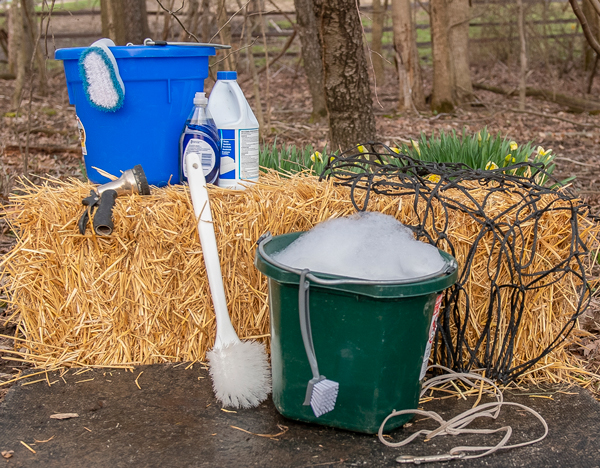
Tools for the Chore
To get started with cleaning horse feed equipment, gather the following cleaning tools:
◆ Long rubber household cleaning gloves or nitrile gloves
◆ Safety glasses or goggles
◆ A bucket, clean plastic jug or wash tub of known capacity to mix cleaning and disinfecting solutions
◆ A measuring cup and measuring spoons to measure the correct amount of disinfectant for the mix
◆ Scrub brushes of various sizes and shapes
◆ Clean rags or towels
◆ A quart-sized spray bottle or water hose attachment for mixing and applying garden fertilizer
◆ Dish detergent
◆ A disinfectant (chosen with the help of a veterinarian)
◆ A deep sink or hose attached to a water source (having hot and cold water is a plus, but cold water will do)
Choose a place to do the washing and rinsing carefully since chlorine bleach and other disinfectants can kill grass and other plants. And, all of the water used in the process will make mud, which is no fun to walk through, much less push a wheelbarrow through. So, choose somewhere where the washing process and runoff won’t cause issues, such as a gravel driveway or parking area, a concrete slab, or an asphalt driveway or out-of-way barn aisle.
Keep in mind that many of the disinfectants will cause bleached spots or stains on clothing, and the entire process is like going to a water park—you are going to get wet! Consider wearing a pair of coveralls or a rain slicker or old clothes. And, boots or muckers are useful to keep your feet dry. Wear gloves and safety glasses to protect your skin and eyes.
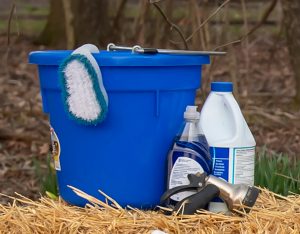
The biggest decision is which disinfectant to use. According to Norman, that choice really depends on the organisms (bacteria, viruses, fungi, molds) you are trying to kill and the surfaces you are cleaning. She adds that some pathogens are more resistant than others, and that although chlorine bleach can be effective against many common disease organisms, it is not effective against certain ones, such as equine herpesvirus-1 (EHV 1, also known as equine rhinopneumonitis) and some others.
In the case of a disease outbreak, she says a state veterinarian would direct barn managers and horse owners on which products would be most effective against the specific organisms in each case.
For routine cleaning your local veterinarian should be able to advise you on what products to use, and in some cases, they may need to assist you with ordering those products. A list of resources is at the end of this article, as well.
Laurent L. Couëtil, DVM, Ph.D., head of Large Animal Internal Medicine and the director of Equine Research Programs at the Purdue University College of Veterinary Medicine, says that in their large animal hospital, they use a strict cleaning and disinfecting regimen in between each patient since they are a treatment facility and often deal with sick animals.
After removing all of the bedding, the staff there do a thorough stall cleaning, first with detergent and rinsing and then applying bleach and rinsing again. After that they apply another disinfectant called Virex (a quaternary ammonium compound) and let that sit for 15 minutes, after which they rinse again. Finally, they finish with rinsing the floor drains and then filling them with disinfectant.
Proper Disinfection
For a boarding stable and family farm purposes, Couëtil offers his advice for routine cleaning of horse feed equipment. “At home, the first step is to remove organic matter by hosing down and scrubbing surfaces with detergent. Bleach is an excellent all-around disinfectant against many viruses, bacteria and fungi, but it does not work well if there is organic matter present (e.g. manure). Therefore, deep cleaning with abundant water hosing to remove organic matter is essential. Remember: The solution to pollution is dilution.
Couëtil stresses that label directions should be followed. “It is also important to use proper bleach dilution (10% or 1.5 cups per gallon of water),” he says. “Using undiluted bleach is very irritating to the eyes and respiratory tract and does not work better than diluted bleach.
“There are many other disinfectants available commercially, but it is very important to read the label to use the appropriate dilution and to determine if it is appropriate for the barn (and kills most common infectious agents),” continues Couëtil. “Deviating from the recommended dilution may result in decreased effectiveness. In other words, more is not better. I would advise against homemade disinfectants. There are lots of affordable commercial products that have been tested, and if properly used, are not toxic for people or animals.”
It should be mentioned that although vinegar and baking soda are great for removing odors and “freshening” buckets and feed tubs, neither is particularly good at killing disease organisms. So, reserve these kitchen staples for odor-eating and using as safe, non-toxic scrubs. Vinegar is an effective lime scale remover if you are dealing with hard water marks.
Safety Note: Never mix cleaning products (dish detergent or ammonia) with disinfecting products, such as chlorine bleach or name-brand disinfectants, since combining the two can create toxic gases, which can kill you or damage your lungs.
A helpful list of disinfectants, noting what pathogens they are effective against, is available on the Equine Disease Communication Center’s website. And, an information-filled downloadable pdf called “Disinfection 101” is also available.
Cleaning vs. Disinfecting
Understanding that “cleaning” and “disinfecting” are actually two different steps in the process is key. Cleaning is using a detergent (a cleaner that “emulsifies” organic matter, such as horse manure, soil, bird droppings, mold, etc.) to make it easier to remove that dirt and grime from a surface. Disinfecting involves applying a chemical cleaner to kill bacteria, viruses, fungi and/or molds.
Some surfaces are much easier to clean and disinfect than others. Non-porous materials like concrete, glass, metal and plastic are much easier to rid of dirt and germs effectively, while porous surfaces, such as wood are much more difficult to clean and disinfect.
Step-By-Step Cleaning and Disinfecting Process
1. Line up all supplies and tools, and think through the process of cleaning your horse feed equipment ahead of time.
2. Put on protective gear—gloves, safety glasses, overalls or old clothes, boots, etc.
3. If an item is excessively dirty or has caked on mud or manure, pre-rinse before washing with detergent.
4. Mix detergent and water in a bucket or large wash basin or in a clean plastic jug to make a cleaning solution. An empty water trough can also make a handy washing sink, and the water trough will end up clean, too. Either submerge the items to be washed in the wash basin or pour the detergent water into or over the item to be cleaned while spreading around the suds with a scrub brush. Make sure to have enough sudsy liquid in the bottom of the bucket or feed tub being washed to splash or brush the solution up the sides and around the rim.
5. Apply “elbow grease” with a scrub brush, going over all surfaces with sudsy water, and reapplying more wash liquid as needed until all interior and exterior surfaces have been scrubbed well.
6. Rinse with plain water.
7. Then examine the item to see if it is clean. Reapply detergent and scrub and rinse again, if needed, to remove any additional dirt and grime.
8. Mix the disinfectant (carefully chosen for the task) with water in the prescribed amount. Mix new disinfectant solution each time you clean, since it may lose effectiveness once mixed with water and after sitting for a time; review package directions for more information.
9. Apply disinfectant solution to the object with a sprayer or sponge, and allow it to sit for around 10–15 minutes, making sure the surface stays wet with the solution (check package instructions to see how long it needs to stay on a surface).
10. When all looks sparkly clean, rinse the object well inside and out with water again.
11. Air dry the cleaned object before stowing or reusing.
12. Hay nets can be laundered in a washing machine and then be line dried or hand washed with detergent, rinsed, soaked in a disinfectant solution, rinsed again and hung to dry.
More Barn Clean-Up Notes
Buckets, feed tubs, water troughs, feed scoops, wheelbarrows, feed carts, and barn tools are all made of non-porous materials. They can all be washed and disinfected using the above steps. Remember to apply a light coating of WD40, or similar product, to the metal parts of barn tools to prevent rust if they are going to be stored for a long period of time.
Wooden stall walls and dirt/clay/sand/gravel stall floors are examples of porous materials that are much harder to clean, because dirt and disease organisms can hide in the cracks and crevices. Porous surfaces require different strategies. Stall walls require hands-on scrubbing, sometimes repeated multiple times, lots of rinsing, and perhaps a different type of disinfectant.
Porous stall floors should be scraped of all organic matter, ag lime applied, and air dried using fans and open windows and doors. On warm, sunny days, it always helps to let air flow through and sunshine into stalls and barn aisles since pathogens often need dark, moist environments to grow. When cleaning stalls, don’t forget to pull the stall mats and clean and disinfect them on both sides and let them, and the floor underneath, air dry before replacing.
Barn towels, leg wraps, horse blankets and stable sheets, and other “horse laundry,” should be shaken or vacuumed, possibly pre-rinsed and stains pre-treated, laundered, and machine-dried or air-dried according to manufacturer’s directions, repaired as necessary, and finally stored in tack trunks or plastic storage bags/tubs until needed again. If your goal is to disinfect often-touched surfaces in barn aisles and tack rooms, don’t forget cross-ties, light switches, water hydrant handles, and door and drawer handles.
Grooming tools and supplies should also be cleaned. Brushes, curries and combs, as well as plastic spray bottles, can be scrubbed in dish detergent water, then rinsed and soaked in disinfectant for at least 15 minutes, then rinsed again, and air dried.

